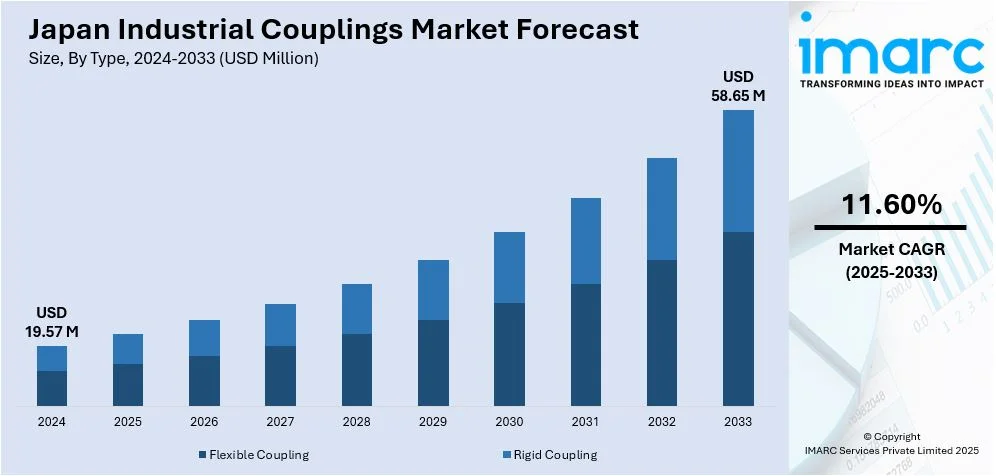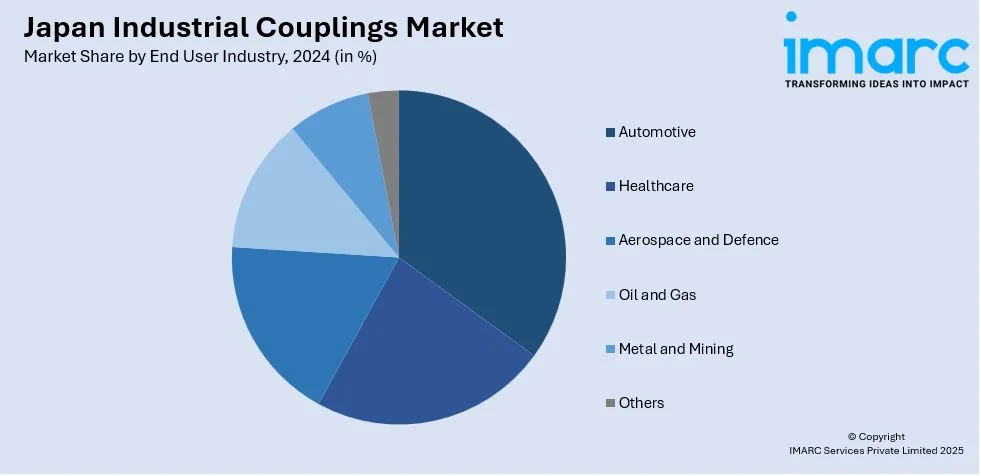
Japan Industrial Couplings Market Size, Share, Trends and Forecast by Type, End User Industry, and Region, 2025-2033
Japan Industrial Couplings Market Overview:
The Japan industrial couplings market size reached USD 19.57 Million in 2024. Looking forward, IMARC Group expects the market to reach USD 58.65 Million by 2033, exhibiting a growth rate (CAGR) of 11.60% during 2025-2033. The increasing automation in manufacturing, rising machine tool production, and high adoption of robotics are supporting the market growth. Moreover, the demand for maintenance-free components, expansion of the electric vehicle sector, growth in renewable energy projects, and integration of Industry 4.0 technologies are fueling the market growth. Apart from this, retrofitting of aging machinery, rising infrastructure development, preference for vibration-reducing solutions, increased use of high-speed rotating systems, and a broader focus on minimizing operational downtime across precision-intensive industries are boosting the Japan industrial couplings market share.
|
Report Attribute
|
Key Statistics
|
|---|---|
|
Base Year
|
2024 |
|
Forecast Years
|
2025-2033
|
|
Historical Years
|
2019-2024
|
| Market Size in 2024 | USD 19.57 Million |
| Market Forecast in 2033 | USD 58.65 Million |
| Market Growth Rate 2025-2033 | 11.60% |
Japan Industrial Couplings Market Trends:
Expansion of Manufacturing Automation
Japan is increasingly adopting manufacturing automation to address labor shortages and enhance productivity. As of 2024, the country had approximately 435,299 industrial robots operating in its factories, marking a 5% increase from the previous year. This positions Japan as one of the most robotized nations globally, second only to China in terms of annual installations. The aging population and declining birth rates have led to a projected shortfall of 11 million workers by 2040, prompting industries to invest in automation technologies. This shift necessitates the use of reliable and efficient couplings to ensure seamless operation of automated machinery. Moreover, Japan's "Society 5.0" initiative aims to integrate cyberspace and physical space, promoting the use of advanced technologies like artificial intelligence (AI) and the Internet of Things (IoT) in manufacturing. This further drives the demand for high-performance couplings that can support complex and precise operations in automated systems.

Growth in Machine Tools and Robotics Industries
Japan's machine tool and robotics industries are experiencing significant growth, driven by advancements in precision manufacturing and automation technologies. In 2022, the production value of machine tools in Japan reached approximately USD 6.90 billion (¥1,078.8 billion), accounting for 6.5% of the general machinery sector. Despite a 14.8% year-on-year decrease in machine tool orders in fiscal year 2023, the total orders remained substantial at USD 9.30 billion (¥1,453.1 billion). This indicates a sustained demand for machine tools, which are integral to various sectors such as automotive, electronics, and aerospace. The increasing complexity and precision required in modern manufacturing processes necessitate the use of advanced couplings that can handle high-speed and high-torque applications. As Japan continues to lead in the production of industrial robots, the demand for specialized couplings that can ensure the reliability and efficiency of robotic systems is expected to rise, which is driving the Japan industrial couplings market growth.
Rising Demand for Maintenance-Free Components
There is a growing demand in Japan for maintenance-free industrial components, particularly in sectors like steel manufacturing and chemical processing. The Japanese steel industry, for instance, is implementing various structural reforms to enhance efficiency and reduce operational costs . Efforts include idling blast furnaces and consolidating production bases, as well as deploying data utilization at production sites. These initiatives aim to streamline operations and minimize downtime, highlighting the importance of maintenance-free components that can operate reliably over extended periods without the need for frequent servicing. Such components are essential in maintaining continuous production and achieving cost-effectiveness in industrial processes. The trend towards maintenance-free solutions is also driven by the need to address labor shortages and enhance the sustainability of manufacturing operations. As industries strive to optimize their processes and reduce maintenance-related disruptions, the demand for durable and reliable couplings that require minimal upkeep is expected to increase.
Japan Industrial Couplings Market Segmentation:
IMARC Group provides an analysis of the key trends in each segment of the market, along with forecasts at the country and regional levels for 2025-2033. Our report has categorized the market based on type and end user industry.
Type Insights:
- Flexible Coupling
- Rigid Coupling
The report has provided a detailed breakup and analysis of the market based on the type. This includes flexible coupling and rigid coupling.
End User Industry Insights:

- Automotive
- Healthcare
- Aerospace and Defense
- Oil and Gas
- Metal and Mining
- Others
A detailed breakup and analysis of the market based on the end user industry have also been provided in the report. This includes automotive, healthcare, aerospace and defense, oil and gas, metal and mining, and others.
Regional Insights:
- Kanto Region
- Kansai/Kinki Region
- Central/Chubu Region
- Kyushu-Okinawa Region
- Tohoku Region
- Chugoku Region
- Hokkaido Region
- Shikoku Region
The report has also provided a comprehensive analysis of all the major regional markets, which include Kanto Region, Kansai/Kinki Region, Central/Chubu Region, Kyushu-Okinawa Region, Tohoku Region, Chugoku Region, Hokkaido Region, and Shikoku Region.
Competitive Landscape:
The market research report has also provided a comprehensive analysis of the competitive landscape. Competitive analysis such as market structure, key player positioning, top winning strategies, competitive dashboard, and company evaluation quadrant has been covered in the report. Also, detailed profiles of all major companies have been provided.
Japan Industrial Couplings Market Report Coverage:
| Report Features | Details |
|---|---|
| Base Year of the Analysis | 2024 |
| Historical Period | 2019-2024 |
| Forecast Period | 2025-2033 |
| Units | Million USD |
| Scope of the Report |
Exploration of Historical Trends and Market Outlook, Industry Catalysts and Challenges, Segment-Wise Historical and Future Market Assessment:
|
| Types Covered | Flexible Coupling, Rigid Coupling |
| End User Industries Covered | Automotive, Healthcare, Aerospace and Defense, Oil and Gas, Metal and Mining, Others |
| Regions Covered | Kanto Region, Kansai/Kinki Region, Central/Chubu Region, Kyushu-Okinawa Region, Tohoku Region, Chugoku Region, Hokkaido Region, Shikoku Region |
| Customization Scope | 10% Free Customization |
| Post-Sale Analyst Support | 10-12 Weeks |
| Delivery Format | PDF and Excel through Email (We can also provide the editable version of the report in PPT/Word format on special request) |
Key Questions Answered in This Report:
- How has the Japan industrial couplings market performed so far and how will it perform in the coming years?
- What is the breakup of the Japan industrial couplings market on the basis of type?
- What is the breakup of the Japan industrial couplings market on the basis of end user industry?
- What is the breakup of the Japan industrial couplings market on the basis of region?
- What are the various stages in the value chain of the Japan industrial couplings market?
- What are the key driving factors and challenges in the Japan industrial couplings market?
- What is the structure of the Japan industrial couplings market and who are the key players?
- What is the degree of competition in the Japan industrial couplings market?
Key Benefits for Stakeholders:
- IMARC’s industry report offers a comprehensive quantitative analysis of various market segments, historical and current market trends, market forecasts, and dynamics of the Japan industrial couplings market from 2019-2033.
- The research report provides the latest information on the market drivers, challenges, and opportunities in the Japan industrial couplings market.
- Porter's five forces analysis assist stakeholders in assessing the impact of new entrants, competitive rivalry, supplier power, buyer power, and the threat of substitution. It helps stakeholders to analyze the level of competition within the Japan industrial couplings industry and its attractiveness.
- Competitive landscape allows stakeholders to understand their competitive environment and provides an insight into the current positions of key players in the market.
Need more help?
- Speak to our experienced analysts for insights on the current market scenarios.
- Include additional segments and countries to customize the report as per your requirement.
- Gain an unparalleled competitive advantage in your domain by understanding how to utilize the report and positively impacting your operations and revenue.
- For further assistance, please connect with our analysts.
 Request Customization
Request Customization
 Speak to an Analyst
Speak to an Analyst
 Request Brochure
Request Brochure
 Inquire Before Buying
Inquire Before Buying




.webp)




.webp)












